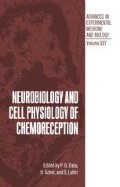Abstract
The carotid body (CB) was defined as a sensory organ by De Castro in 1928. Two years later, Heymanns and coworkers demostrated that the organ was sensitive to alterations in blood gases and pH, in such a way that a decrease in blood PO2 or pH or an increase in blood PCO2 produced activation of the CB and, reflexely, hyperventilation. De Castro postulated that glomus cells were the sensor structures and that they should release some substance to transmit the stimulus to the sensory nerve endings (De Castro, 1928). De Castro’s point of view, was widely accepted, and therefore the CB was considered a secondary sensory receptor. As a consequence, the principal aims of many workers in the chemoreception field have been to define the nature of the sensing mechanims (sensory transduction process) and to identify the substances released by chemoreceptor cells.
Access this chapter
Tax calculation will be finalised at checkout
Purchases are for personal use only
Preview
Unable to display preview. Download preview PDF.
References
Acker, H., Fidone,S., Pallot,D.,Eyzaguirre,C., Lübbers,D.W., and Torrance,R. W.,1977, eds., “Chemoreception in the Carotid Body”.
Almaraz, L., Gonzalez, C., and Obeso, A., 1986, Effects of high potassium on the release of 3H-dopamine from the cat carotid body in vitroJ, Physiol 379:293.
Baker, P.F., and Knight, D.E., 1984, Calcium control of exocytosis in bovine adrenal medullary cells, TINS, 4:120.
Biscoe, T.J., 1971, Carotid body: structure and function. Physiol. Rev. 51:427.
Biscoe, T.J., and Duchen, M.R. 1990, Cellular basis of transduction in carotid chemoreceptors, Am. J. Physiol„ 258:L271.
Biscoe,T.J., Duchen, M.R., Eisner, D.A., O’Neill, S.C., and Valdeolmillos, M., 1989, Measurements of intracellular Ca2+ in dissociated type I cells of the rabbit carotid body, J. Physiol. 416:421.
Buckler, K.J., Vaughan-Jones, C., Peers, C., and Nye, P.C.G., 1991, Intracellular pH and its regulation in isolated type I carotid body cells of the neonatal rat, J.Physiol. 436:197.
De Castro, F., 1928, Sur la structure et l’innervation du sinus carotidiende l’homme et des mammiferes. Nouveaux faits sur l’innervation et la fonction du glomus caroticum. Etudes anatomiques et physiologiques, Trab. Lab. Invest. Biol. Univ. Madrid 25:331.
Douglas, W. W., 1968, Stimulus-secretion coupling: The concept and clues from chromaffin and other cells, Br.J.Pharmacol. 34:451.
Duchen,M.R., Caddy,K.W., Kirby,G.C., Patterson,D.L., Ponte,J.,and Biscoe,T.J.,1988, Biophysical studies of the cellular elements of the rabbit carotid body, Neuroscience 26:291.
Eyzaguirre, C., and Lewin, J.,1961, Chemoreceptor activity of the carotid body of the cat, J. Physiol. 159:222.
Eyzaguirre, C., and Zapata, P., 1968, A discussion of possible transmitter or generatorsubstances in carotid body chemoreceptors, in: “Arterial chemoreceptors,” R.W., Torrance, ed., Blackwell, Oxford.
Eyzaguirre, C., Fidone, S., and Nishi, K., 1975, Recent studies on the generation of chemoreceptor impulses, in: “The Peripheral Arterial Chemoreceptors,” M.J., Purves, ed., Cambridge Univ. Press., London.
Fidone, S.J., and Gonzalez, C., 1986, Initiation and control of chemoreceptoractivity in the carotid body, in: “Handbook of Physiology. The respiratory system II,” A.P., Fishman, ed., Am. Physiological Society, Bethesda.
Rocher, A., Obeso, A., Gonzalez, C., and Herreros, B., 1991, Ionic mechanisms for the transduction of acidic stimuli in rabbit carotid body glomus cells, J. Physiol. 433:533.
Rocher, A., Obeso, A., Herreros, B., and González, C.,1988, Activation of the release of dopamine in the carotid body by veratridine. Evidence for the presence of voltage-dependent Na+channels in type I cells. Neurosci. Lett. 94:274.
Shaw, K., Montague, W. & Pallot, D.J., 1989, Biochemical studies on the release of catecholamines from the rat carotid body in vitro, Biochim. Biophys. Acta. 1013:42.
Starlinger, H., and Lübbers, D.W., 1976, Oxygen consumption of the isolated carotid body tissue (cat), Pfliigers Arch 366:61.
Stea, A., and Nurse, CA, 1991, Whole-cell and perforated-patch recordings from O2- sensitive rat carotid body cells grown in short-and long-term culture, Pfliigers Arch 418:93.
Torrance, R.W., 1968, ed., “Arterial Chemoreceptors”.
Urefña, J., López-López, J.R., Gonzalez, C., and López Barneo, J., 1989, Ionic currents in dispersed chemoreceptor cells of the mammalian carotid body, J. Gen. Physiol. 93:979.
VanBuskirk, R., and Dowling, J.E., 1982, Calcium alters the sensitivity of intact horizontal cells to dopamine antagonists., Proc. Natl. Acad. Sci. USA. 79:3350.
Verna, A., Roumy, M., and Leitner, L.M., 1981, Ultrastructural features of the carotid body after in vitro experiments: correlation with physiological results, J.Neurocyol. 10:659.
Whalen, W J., andNair, P., 1976, PO2 in the carotid body perfused and/or superfused with cell-free media, J. Appl. Physiol. 41:180.
Author information
Authors and Affiliations
Editor information
Editors and Affiliations
Rights and permissions
Copyright information
© 1993 Springer Science+Business Media New York
About this chapter
Cite this chapter
González, C., López-López, J.R., Obeso, A., Rocher, A., García-Sancho, J. (1993). Ca2+ Dynamics in Chemoreceptor Cells: An Overview. In: Data, P.G., Acker, H., Lahiri, S. (eds) Neurobiology and Cell Physiology of Chemoreception. Advances in Experimental Medicine and Biology, vol 337. Springer, Boston, MA. https://doi.org/10.1007/978-1-4615-2966-8_21
Download citation
DOI: https://doi.org/10.1007/978-1-4615-2966-8_21
Publisher Name: Springer, Boston, MA
Print ISBN: 978-1-4613-6290-6
Online ISBN: 978-1-4615-2966-8
eBook Packages: Springer Book Archive

